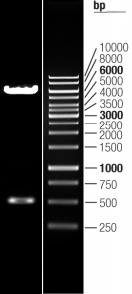 首页>
生物试剂
首页>
生物试剂
商家描述
产品评价(0)
商品介绍
gene_symbol:Isocitrate dehydrogenase
Synonyms:HEL-216; HEL-S-26; IDCD; IDH; IDP; IDPC; PICD
clone_name:OTI2H9
immunogen:Full-length protein expressed in 293T cell transfected with human IDH1 expression vector
predicted_size:46.7 kDa
background:Isocitrate dehydrogenases catalyze the oxidative decarboxylation of isocitrate to 2-oxoglutarate. These enzymes belong to two distinct subclasses, one of which utilizes NAD(+) as the electron acceptor and the other NADP(+). Five isocitrate dehydrogenases have been reported: three NAD(+)-dependent isocitrate dehydrogenases, which localize to the mitochondrial matrix, and two NADP(+)-dependent isocitrate dehydrogenases, one of which is mitochondrial and the other predominantly cytosolic. Each NADP(+)-dependent isozyme is a homodimer. The protein encoded by this gene is the NADP(+)-dependent isocitrate dehydrogenase found in the cytoplasm and peroxisomes. It contains the PTS-1 peroxisomal targeting signal sequence. The presence of this enzyme in peroxisomes suggests roles in the regeneration of NADPH for intraperoxisomal reductions, such as the conversion of 2, 4-dienoyl-CoAs to 3-enoyl-CoAs, as well as in peroxisomal reactions that consume 2-oxoglutarate, namely the alpha-hydroxylation of phytanic acid. The cytoplasmic enzyme serves a significant role in cytoplasmic NADPH production.
buffer:PBS (pH 7.3) containing 1% BSA, 50% glycerol and 0.02% sodium azide.
purification:Purified from mouse ascites fluids or tissue culture supernatant by affinity chromatography (protein A/G)
isotype:IgG1
host:Mouse
applications:IF, WB
Recommend Dilution:WB 1:2000, IHC 1:50, IF 1:100
reactivities:Human, Mouse, Rat
storage:Store at -20°C as received.
gene_symbol:Isocitrate dehydrogenase
Synonyms:HEL-216; HEL-S-26; IDCD; IDH; IDP; IDPC; PICD
clone_name:OTI2H9
immunogen:Full-length protein expressed in 293T cell transfected with human IDH1 expression vector
predicted_size:46.7 kDa
background:Isocitrate dehydrogenases catalyze the oxidative decarboxylation of isocitrate to 2-oxoglutarate. These enzymes belong to two distinct subclasses, one of which utilizes NAD(+) as the electron acceptor and the other NADP(+). Five isocitrate dehydrogenases have been reported: three NAD(+)-dependent isocitrate dehydrogenases, which localize to the mitochondrial matrix, and two NADP(+)-dependent isocitrate dehydrogenases, one of which is mitochondrial and the other predominantly cytosolic. Each NADP(+)-dependent isozyme is a homodimer. The protein encoded by this gene is the NADP(+)-dependent isocitrate dehydrogenase found in the cytoplasm and peroxisomes. It contains the PTS-1 peroxisomal targeting signal sequence. The presence of this enzyme in peroxisomes suggests roles in the regeneration of NADPH for intraperoxisomal reductions, such as the conversion of 2, 4-dienoyl-CoAs to 3-enoyl-CoAs, as well as in peroxisomal reactions that consume 2-oxoglutarate, namely the alpha-hydroxylation of phytanic acid. The cytoplasmic enzyme serves a significant role in cytoplasmic NADPH production.
buffer:PBS (pH 7.3) containing 1% BSA, 50% glycerol and 0.02% sodium azide.
purification:Purified from mouse ascites fluids or tissue culture supernatant by affinity chromatography (protein A/G)
isotype:IgG1
host:Mouse
applications:IF, WB
Recommend Dilution:WB 1:2000, IHC 1:50, IF 1:100
reactivities:Human, Mouse, Rat
storage:Store at -20°C as received.
 会员登录
会员登录.getTime()%>)
 购物车()
购物车()

 成功收藏产品
成功收藏产品